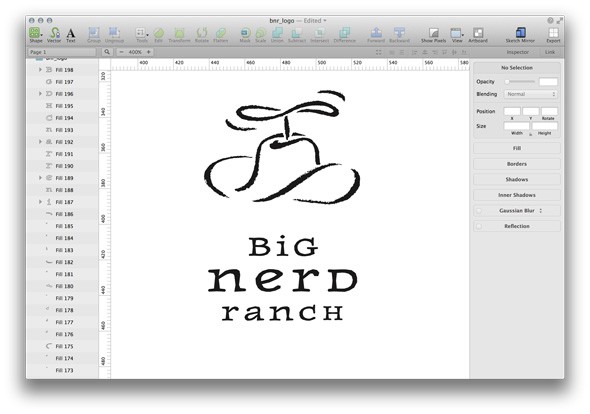
Writing is Designing: Three Principles for Writing Effective UX Copy
Design MarketingImagine, if you will, that you’ve discovered a cute new gem of a bakery. The pastry chef welcomes you into the ambient, delightfully quirky...

Centered around vector design and containing useful tools, Sketch is getting plenty of buzz among UI designers as an alternative to Adobe’s Creative Suite. But how does it stack up?
Sketch gains a lot from being new and shiny. For one, it doesn’t run on the slow platform that Creative Suite programs do. For another, it’s geared specifically for digital-only, app-centric projects. It doesn’t have cruft for photographers, it doesn’t clutter the workspace with a million panels, and changing aspects of elements is clear and helpful. All this means that Sketch is pretty fast at what I use it for.
With Sketch, designs come out pixel perfect and in vector format, a requirement for multiple screen sizes. Shapes are easy to combine. You have the ability to preview on your device using Sketch Mirror, and @1x and @2x exporting is baked in, if you’re into that sort of thing. Sketch does all this with even less interface than Adobe Illustrator—and often does so more cleanly.
However, there are tradeoffs to using Sketch. At times, a bug (like a disappearing panel or weird artifacts all over the place) will appear in the beta version, requiring you to restart or simply wait for a fix.
Many of the frustrations I run into are leftovers from working with other programs. Handling layers and groups feels unintuitive in Sketch. Its guides seem slow and clunky. Why do I have to click twice to create a guide? It’s not that big a deal to some, but I’m all about shaving seconds off my workflow. I often use GuideGuide in Photoshop to create quick and easy guides, and I utilize many other extensions for saving files, resizing graphics and more.
Which brings me to another issue when it comes to using Sketch: a lack of extensions. A couple of notable exceptions are Ale Muñoz’s Orange Commands and Thomas Seng Hin Mak’s Sketch Plugin Scripts.
Sketch’s developers are a small team, and they are working as hard as they can to make Sketch great (use the beta for a few days and see how often you get bug fixes and improved features—it’s impressive). But the ‘Shop, and even Illustrator, have larger libraries of extensions and collections of design assets, not to mention the control they provide over your work. It’s for those reasons that many designers haven’t switched, and it’s part of why we eagerly await Skala, a competitor from the detail-oriented Bjango, slated for beta in late 2013.
Sketch covers only part of a workflow. I often use pen and paper or a whiteboard first, and then move on to wireframes as necessary. Sketch will handle low- to high-fidelity wireframes with ease, though Omnigraffle is hard not to reach for, thanks to some of its time-saving features.
Pick your poison: faster low-fidelity wireframes in something like Omnigraffle (good if you’re in an iterative workflow) and recreation in Sketch when you need higher fidelity, or slower low-fidelity wireframes and faster translation into mockups. Either pairs well with Flinto, my go-to prototyping app.
Sketch also plays well with Illustrator if exported into the SVG format (PDF and EPS formats don’t work, for some reason). I then use Specctr to handle speccing. It’s a good replacement until Sketch gets its own features.
It depends on a couple of things. Are you willing to wait and see if Skala will be any good? If so, I’d check that out before you go learning a new workflow. Keep in mind that even if Sketch is easier than Illustrator on the whole, you’re probably still faster for the time being on whatever you’re using, if not by much. (It’s kind of like switching from Qwerty to Dvorak. Dvorak is inherently better, but you’re still faster on Qwerty until you’ve made the transition). On the other hand, if you’re just starting out doing UI work, Sketch would be a great way to dive in.
Sketch might also make a good replacement for your current workflow if you’re interested in removing the speccing step and would instead prefer that your developers have access to the files. At $70, it costs less than two months of Creative Cloud. That said, this is not something I’d recommend for most shops. Pair programming/duo designing is often the best way of handling asset creation. Ultimately, your job as a designer is to deliver the assets. You don’t want a programmer mucking around in the layers and they don’t want you in their Categories.
I recommend Sketch. I’ve enjoyed the lighter interface and focused features. It’s actively supported and being iterated on by both the creators and the community. Even if Skala turns out to be great, Sketch will likely continue to be a useful alternative.

Imagine, if you will, that you’ve discovered a cute new gem of a bakery. The pastry chef welcomes you into the ambient, delightfully quirky...

There are several design patterns used these days in the .NET ecosystem. What are they? What are the benefits and drawbacks of each pattern?...

Large organizations with multiple software development departments may find themselves supporting multiple web frameworks across the organization. This can make it challenging to keep...